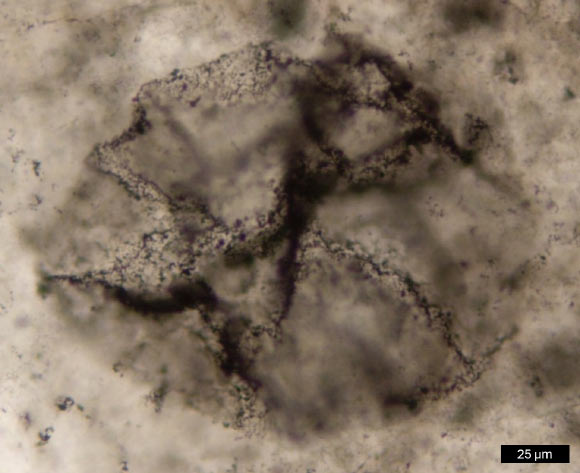Extracting biochemical information from ancient organic-rich sediments, particularly determining the timing of photosynthesis relative to the assumed oxygenation of the Earth's atmosphere, remains challenging. To address this issue, the scientists analyzed 406 diverse ancient and modern samples and used supervised machine learning to distinguish between samples of biogenic and abiogenic origin, as well as photosynthetic and non-photosynthetic physiology. They found chemical evidence of biogenic molecular complexes in Paleoarchean rocks (3.51 billion years ago) and photosynthetic life in Neoarchean rocks (2.52 billion years ago).
The earliest life on Earth left few molecular traces behind.
The few fragile remains, such as ancient cells and microbial mats, were buried, crushed, heated and crushed in the earth's restless crust, and then thrown back to the surface.
These transformations have virtually erased biosignatures that contain vital clues to the origins and early evolution of life.
Paleobiologists looking for signs of the oldest life on Earth have long relied primarily on fossil organisms, including microscopic fossils of single cells and filaments, as well as mineralized remains of cellular structures such as microbial mats and mounded stromatolites, which provide compelling evidence for the existence of life as far back as 3.5 billion years ago. However, such remains are very few.
The second line of evidence is based on the preservation of diagnostic biomolecules in ancient stones.
Life's hardiest organic molecules—derived from cell membranes or certain metabolic processes—have been found in sediments about 1.7 billion years old, while much older carbon-rich rocks retain isotopic signatures that hint at an active biosphere 3.5 billion years ago.
However, most ancient rocks have no fossil cells or preserved biomolecules.
The vast majority of ancient carbonaceous sediments have been heated and altered in such a way that each diagnostic biomolecule is broken into countless small fragments.
These fragments turned out to be too small and too general to provide any clues about ancient life—until now.
“Ancient rocks are full of interesting mysteries that tell us the story of life on Earth, but some pieces are always missing,” said Michigan State University researcher Katie Maloney, co-author of the study.
“The combination of chemical analysis and machine learning has revealed biological clues about ancient life that were previously invisible.”

Organic matter recovered from 2.5 billion-year-old rock samples containing fossilized microorganisms like the one shown in this micrograph still contains biomolecular fragments that may have been produced through photosynthesis. Image credit: Andrew D. Chaya.
The researchers used high-resolution chemical analysis to break down organic and inorganic materials into molecular fragments, and then trained an artificial intelligence system to recognize the chemical fingerprints left behind by life.
In total, they examined 406 fossil, modern biological, meteorite and synthetic samples.
The artificial intelligence model distinguished biological from non-biological materials with over 90% accuracy and discovered the earliest biomolecular evidence:
(i) photosynthetic origin of organic molecules in the 2.52 billion-year-old Gamohaan Formation, Campbellrand Group, South Africa, and the 2.30 billion-year-old Gowganda Group, Ontario, Canada;
(ii) the biogenicity of organic molecules preserved in the 3.51 billion-year-old Singhbhum Craton in India; Josefsdal Devil, 3.33 billion years old, in the Barberton Greenstone Belt, South Africa; and the 2.66 billion-year-old Jerrine Formation, Fortescue Group, Pilbara Craton, Australia;
(iii) and apparently non-photosynthetic origins of organic species in the 3.5 billion-year-old Teespruit Formation, Barberton Greenstone Belt, South Africa, and the 3.48 billion-year-old Dresser Formation, Pilbara Craton, Australia.
“Ancient life leaves behind more than just fossils; it leaves chemical echoes,” said senior author Dr. Robert Hazen, a researcher at the Carnegie Institution for Science.
“Using machine learning, we can now reliably interpret these echoes for the first time.”
“This innovative method helps us read the deep-time fossil record in new ways,” Dr Maloney added.
“This could help in the search for life on other planets.”
“Understanding when photosynthesis emerged helps explain how Earth's atmosphere became oxygen-rich, a key milestone that allowed complex life, including humans, to evolve,” said first author Dr. Michael Wong, also of the Carnegie Institution for Science.
“This represents an inspiring example of how modern technology can shed light on the planet's oldest histories and change the way we search for ancient life on Earth and on other worlds.”
“In the future, we plan to test materials such as anoxygenic photosynthetic bacteria – possible analogues of extraterrestrial organisms. This is a powerful new tool for astrobiology.”
“These samples and the spectral signatures they produce have been studied for decades, but AI offers a powerful new lens that allows us to extract important information and better understand their nature,” added Dr. Anirudh Prabhu of the Carnegie Institution for Science, co-author of the study.
“Even when degradation makes it difficult to detect signs of life, our machine learning models can still detect subtle traces left by ancient biological processes.”
“What's interesting is that this approach is not based on finding recognizable fossils or intact biomolecules.”
“AI didn’t just help us analyze data faster, it allowed us to make sense of messy, degraded chemical data.”
“This opens the door to exploring ancient and alien environments with fresh eyes, guided by patterns we may not even be aware of.”
teams results will appear this week in Proceedings of the National Academy of Sciences.
_____
Michael L. Wong etc.. 2025. Organic geochemical evidence of life in Archean rocks revealed by pyrolysis-GC-MS and supervised machine learning. PNAS 122 (47): e2514534122; doi: 10.1073/pnas.2514534122








